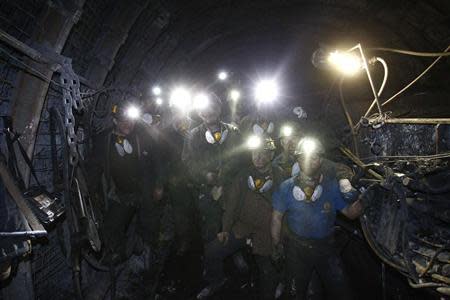Poland could halve demand for coal by 2030, study says

By Environment Correspondent Alister Doyle OSLO (Reuters) - Poland could halve its demand for coal by 2030 with a shift to renewable energies that would end its image as a laggard in European Union efforts to slow climate change, a study showed on Friday. The report, by researchers in Germany and Poland, renewable energy groups and environmental group Greenpeace, included a foreword by ex-Polish Environment Minister Maciej Nowicki who called it a "feasible, realistic scenario". It estimated that Poland, which now generates 90 percent of its electricity from coal, could create 100,000 jobs with a shift to wind, hydro, biomass, geothermal and solar power by 2030. The scenario would require investment of $264 billion, double the $132 billion cost of business as usual. Still, free renewable energies would be cheaper in the long run by eliminating costs of fuel to generate electricity, it said. Poland "has a once-in-a-generation opportunity to move beyond coal," it said. "Poland is home to a geriatric energy system, based on coal. Its power plants are old with about 70 percent of them being over 30 years old." Poland has often been among the EU nations most reluctant to cut use of fossil fuels to fight global warming. A shift from coal would make it surpass many current EU goals. Warsaw faces a test next month when it hosts a 200-nation conference from November 11-22 that will work on a global deal, due to be agreed in 2015, to slow climate change. HALVE COAL Friday's report was by the Warsaw-based Institute for Renewable Energy, DLR (Germany's aeronautics and space research center), the European Renewable Energy Council, the Global Wind Energy Council and Greenpeace. It said Poland could halve its coal plant electricity generation to 60 terawatt hours a year by 2030 from a current 120. Renewable energy sources accounted for 7.8 percent of Poland's primary energy demand in 2010 and could rise to 26.8 percent by 2030 with a strong shift from coal, the study said. "We wanted to show what Poland could do," Sven Teske, Renewable Energy Director of Greenpeace International, told Reuters of the study. He noted that neighboring Germany, with a similar climate, was a leader in wind and solar power. Poland's official energy plans for 2030 predict that coal will remain the cornerstone of power generation as it works to improve energy efficiency and to diversify to renewables. Yvo de Boer, former head of the U.N. Climate Change Secretariat who now works at global audit firm KPMG, said Poland's dilemmas were abundant coal, an energy infrastructure geared to coal and a fear of relying on Russia for energy. Poland worries about "ignoring a domestically available energy resource and destroying a lot of capital stock to become more dependent on Russia," he told Reuters. "The difficulty is to square that circle." (This story has been corrected to fix units in paragraph 9 after a correction to press release) (Reporting By Alister Doyle; editing by David Evans)

 Yahoo News
Yahoo News 